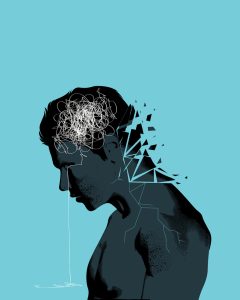Exploring the Mind: Understanding the Phenomenon of Dissociation

- Dissociation is a coping mechanism for overwhelming stress or trauma, leading to disconnection from reality.
- Dissociation can act as a catalyst for spiritual awakening, prompting individuals to question their reality and seek answers beyond the physical world.
- Dissociation can create an opportunity for individuals to release past traumas and access a deeper sense of self.
- There is a complex and intricate link between dissociation and spiritual insights, leading to personal growth and transformation.
Understanding Dissociation
What Is Dissociation?
Dissociation is a psychological coping mechanism that activates when an individual is faced with overwhelming stress or trauma. It represents a disconnection from reality, often resulting in disruptions to memory, emotions, and identity.
Common symptoms of dissociation include:
- Feeling as though one is in a trance or daydream
- Memory loss or difficulty with recall
- A sense of detachment from oneself or the environment
- Emotional numbness or being overwhelmed
- Loss of control over emotions
- Sensory disconnection, such as impaired touch or vision
Dissociation serves as a protective barrier, allowing individuals to distance themselves from distressing experiences. While it can be a temporary refuge, persistent dissociative states may require professional intervention to address underlying issues and restore a sense of reality.
Grounding Oneself
One who experiences dissociation may sometimes try to calm oneself due to the manifested trigger. There are multiple ways one can seek grounding techniques to keep oneself from dissociating from reality. Part of grounding can include touching something in the present moment, such as the soft side of a chair, or rubbing one’s feet against the carpet. This type of physical grounding is only one strategy, others also include mental grounding where one utilizes mentally stimulating thoughts such as counting, recalling memories, or other visual affects. Emotional grounding can also be employed with breathing exercises.

It is sometimes extremely important to be able to ground oneself because sometimes if one dissociates, one can harm oneself or others due to lack of attention to driving, or moving around in public. This can lead to accidents, falling, or injuring oneself.
If experiencing these types of issues, contact a mental health professional.
Manifestation of Dissociation
Dissociation is a complex phenomenon that presents itself in various forms, often as a psychological defense mechanism in response to trauma. Symptoms can range from mild detachment to severe disconnection from reality, impacting an individual’s daily functioning and sense of self.
- Feeling as though one is in a trance or daydream
- Experiencing memory loss or difficulty with recall
- Sensing a detachment from oneself or surroundings
- Encountering overwhelming emotions or emotional numbness
- Challenges in controlling emotions
- Disconnection from sensory experiences, such as touch or sight
Dissociation serves as a coping strategy, allowing individuals to distance themselves from extreme stress or traumatic events. This disconnection can be both protective and disruptive, altering one’s perception of reality and interaction with the world.
While the manifestations of dissociation are diverse, they often signal an underlying need for healing and support. Recognizing these signs is the first step towards understanding and addressing the root causes of dissociative experiences.
In addition, the manifestation of this state can lead to isolation, addictions and other ways to help cope with it. It is important to recognize it and seek counseling and help to prevent it from possibly harming oneself.
Types of Dissociative States
Dissociative states are complex phenomena that can be categorized into three primary types: depersonalization, derealization, and dissociative amnesia. Depersonalization involves a sense of detachment from oneself, often described as feeling like an outside observer of one’s own body or thoughts. Derealization is characterized by a feeling of unreality or detachment from the environment, making the world seem foggy or dreamlike. Lastly, dissociative amnesia pertains to gaps in memory for personal information, sometimes specific to traumatic events.
- Depersonalization: Detachment from self
- Derealization: Detachment from environment
- Dissociative Amnesia: Memory gaps
Each type of dissociative state represents a unique way in which the mind copes with stress or trauma. While they can be unsettling, understanding these states is crucial for effective treatment and personal growth.
It’s important to recognize that these states can occur independently or concurrently, and their manifestation can vary greatly among individuals. The experience of dissociation can be transient or part of a more chronic condition, such as dissociative identity disorder. Identifying the type of dissociative state is a critical step in addressing the underlying issues and moving towards healing.
Dissociative states can include according to the DSM-5 various levels of severity. It can include an amnesia state that is simple to complex, a de-attachment state from self or environment or multiple personalities in its most severe form.
Dissociation and the Mind-Body Connection
Impact on Consciousness
Dissociation profoundly affects the landscape of consciousness, often leading to a disruption in the normal integration of thoughts, feelings, and experiences. The alteration in consciousness can range from mild detachment to a more severe disconnection from reality.
- The default mode network, often associated with self-referential thoughts, is impacted during dissociative states.
- Studies using fMRI have shown changes in the prefrontal parietal network, which is crucial for attention and working memory.
- Consciousness supporting networks, including the anterior and posterior cortex, exhibit distinct patterns during dissociative episodes.
Dissociation challenges our understanding of consciousness, revealing the intricate workings of the mind and the delicate balance that sustains our sense of self and reality.
The neural correlates of consciousness, such as the default mode network and the prefrontal parietal network, are key areas of study to unravel the mysteries of dissociation. By examining the changes in these networks, researchers can gain insights into the mechanisms that underlie altered states of consciousness.
Spiritual Awakening
Spiritual awakening is often described as a profound shift in consciousness, where one experiences a deep connection with the essence of being and a recognition of a more expansive reality. It is a transformative journey that can lead to a profound understanding of oneself and the universe.
- A shift in one’s perspective on life
- Detachment from material possessions and ego
- Increased compassion and empathy towards others
- A feeling of oneness with the universe
- A deepened sense of intuition and spiritual connection
While the path to spiritual awakening can be enlightening, it may also bring about challenges such as feelings of alienation or difficulty integrating experiences into everyday life. Nonetheless, the journey is often seen as a pivotal moment in personal growth and self-discovery.
The process of awakening can be spontaneous or induced by practices like meditation. It is marked by a series of internal changes:
- A reevaluation of personal values and beliefs
- An enhanced awareness of life’s interconnectedness
- A pursuit of deeper meaning and purpose beyond the self
Link to Personal Growth
The concept of dissociation, often perceived as a detachment from reality, can paradoxically serve as a bridge to personal growth. Dissociation provides a unique space for reflection and self-exploration, allowing individuals to step back from the immediacy of their experiences and view their lives from a new perspective. This detachment can lead to a deeper understanding of one’s self and the challenges faced, fostering a sense of competence and efficacy.
In the realm of personal development, dissociation can be a catalyst for change, offering an opportunity to reassess one’s goals and values without the interference of external pressures.
The process of personal growth through dissociation can be outlined in the following steps:
- Recognizing the occurrence of dissociative states.
- Understanding the triggers and underlying emotions.
- Utilizing the reflective space provided by dissociation to gain insights.
- Integrating these insights into daily life to foster resilience and adaptability.
This transformative journey can lead to an increase in intrinsic motivation, self-directed learning, and ultimately, a more profound sense of self-realization.
Healing and Transformation
Releasing Past Traumas

Dissociation offers a unique pathway for individuals to confront and release past traumas, paving the way to rediscover a more authentic self. This process often involves delving into the unconscious mind, where unresolved emotions and memories reside. By accessing these hidden parts of the psyche, one can begin the journey of healing and transformation.
Dissociation can serve as a bridge to personal growth, allowing for a re-examination of beliefs and identity. It is in this introspective space that many find the strength to let go of the pain that has held them back.
To facilitate this healing, certain practices can be adopted:
- Breathwork: Engage in breathing exercises to help regulate emotions and achieve a sense of calm.
- Creative expression: Utilize art, music, or writing as outlets for emotional release and self-discovery.
- Mindfulness: Practice being present in the moment to reconnect with oneself and the environment.
While the journey through dissociation can be disorienting, it ultimately can lead to a profound spiritual awakening and a renewed search for meaning and purpose in life.
Accessing Deeper Self
In the journey of healing and transformation, dissociation can serve as a gateway to accessing deeper levels of the self. This process often involves delving into the unconscious mind, where dormant emotions and memories reside. By confronting and releasing these suppressed elements, individuals may experience a profound shift in their sense of identity and consciousness.
- Exploration of beliefs and identity questioning
- Release of past traumas
- Unlocking of unconscious pathways
- Potential for spiritual awakening
The act of accessing one’s deeper self is not just about self-discovery; it’s about reconstructing the very fabric of one’s being from the inside out.
As individuals navigate through this transformative phase, they may find themselves on the precipice of a spiritual awakening. The sense of emptiness that once pervaded their existence begins to fill with a newfound purpose and connection to something greater. This spiritual dimension adds a rich layer to the healing process, offering a sense of wholeness that transcends the individual experience.
Treatment
While coping involves grounding exercises, the best way to overcome and limit the dissociation is facing the trauma and understanding the triggers. Treatments include medications such as anti-psychotics, anxiety reducing medications, anti depressants and sleep aids. Counseling can also help. Individuals can go through cognitive behavioral therapy to better understand and react to the issue when it occurs. One can also better learn to manage emotional reactions to triggers. EDMR can also help de-sensitive individuals to the triggers by discussing and visualizing them in a safe place with a trained mental health professional.
Conclusion
In conclusion, the phenomenon of dissociation is a complex and multifaceted coping mechanism that the brain initiates in response to overwhelming stress or trauma. It manifests in various forms, affecting memory, emotions, and identity. The three types of dissociative states, depersonalization, derealization, and dissociative amnesia, present unique challenges for individuals experiencing dissociation. Additionally, dissociation may trigger spiritual awakening, leading individuals to question their reality and seek answers beyond the physical world. This exploration of dissociation and its potential connection to spiritual awakening provides valuable insights into the intricate workings of the human mind and the profound impact of coping mechanisms on personal growth and transformation. It is also important to understand ways to cope with it but also treat it to prevent serious injury or further pathological onset. While it can help us identify past trauma, it must also be identified and worked on to prevent further issues.

Please also review AIHCP’s Grief Counseling, Crisis Intervention and other mental health certification programs. Licensed professional counselors or human service professionals can enhance their professional expertise with AIHCP’s certifications. The programs are online and independent study and open to qualified professionals.
Frequently Asked Questions
What is dissociation and how does it manifest?
Dissociation refers to a coping mechanism that the brain initiates when dealing with overwhelming stress or anxiety, leading to disconnection from reality. It can manifest in various forms, such as problems with memory, emotions, and identity.
What are the types of dissociative states?
There are three types of dissociative states, including depersonalization, derealization, and dissociative amnesia. Depersonalization: A person feels disconnected from themselves, as if they are watching themselves from a distance.
How does dissociation impact consciousness?
Dissociation causes a split between an individual’s mind and body. In a dissociative episode, an individual might feel like they are watching themselves from a distance, leading to a sense of detachment from their surroundings.
Is dissociation linked to spiritual awakening?
Yes, dissociation can act as a catalyst for spiritual awakening, prompting individuals to question their reality and seek answers that extend beyond the physical world.
How can dissociation lead to personal growth?
Dissociation can create an opportunity for individuals to explore their beliefs and question their identity. This self-reflection can lead to a spiritual awakening as the individual begins to search for meaning and purpose.
What is the relationship between dissociation and reality?
Dissociation is often a response to traumatic experiences, leading individuals to disconnect from reality as a coping mechanism. It can be characterized by feelings of being detached or disoriented and can lead to conditions like dissociative identity disorder.
How can spiritual insights help heal trauma-induced dissociation?
Spiritual insights can broaden one’s consciousness and deepen one’s understanding of life’s interconnectedness, potentially aiding in the healing of trauma-induced dissociation.
What are ways to practice spiritual growth while dissociating?
Embracing spiritual awakening, seeking meaning and purpose, and accessing deeper levels of consciousness are ways to practice spiritual growth while dissociating.
Additional Resources
“How to Stop Dissociating | 17 Grounding & Coping Strategies”. Access here
“What Happens When You Dissociate?”. Pugle, M. (2023). Very Well Health. Access here
“Dissociation”. Psychology Today. Access here
“What Is Dissociation?”. Wiginton, K. (2023). WebMD. Access here
“Dissociative Disorders”. Mayo Clinic. Access here





